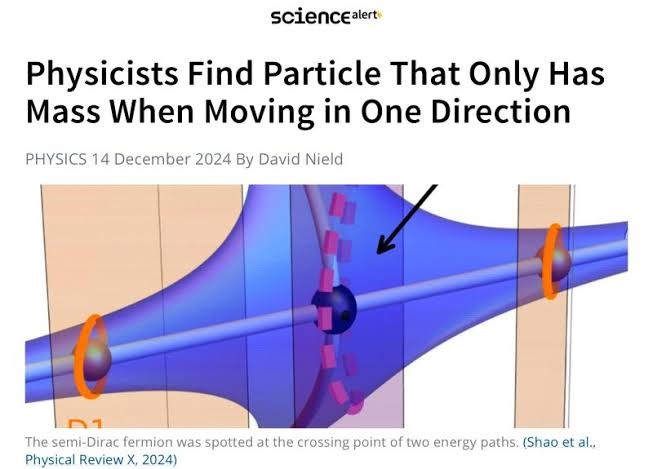Discovering Semi-Dirac Fermion in Particle Physics
Syllabus:
GS 3:
- Science and Technology
- Development and its application in everyday life.
Why in the News?
Physicists have recently discovered a semi-Dirac fermion, a strange subatomic particle, in a material called zirconium silicon sulphide (ZrSiS). This particle exhibits a unique behavior, possessing mass in one direction but not in another, marking a breakthrough in condensed-matter physics.
The Subatomic Zoo: Understanding Particles
- Fermions and bosons: Subatomic particles are categorized as fermions, which form matter, and bosons, which mediate forces. For example, electrons and protons are fermions, while photons are bosons.
- Dirac vs. Majorana fermions: Dirac fermions have mass and are distinct from their anti-particles, whereas Majorana fermions are their own anti-particles, with neutrinos suspected to belong to this group.
- Cataloging particles: The effort to categorize particles meticulously aligns with the Standard Model (SM), which seeks to unify and explain the behavior of all subatomic particles. Gaps in knowledge, such as dark matter and the force of gravity, remain significant challenges.
- Exotic particles in materials: Unlike particles in free space, those in solids and liquids interact uniquely with their environment. Materials like graphene and ZrSiS host such exotic particles, enabling table-top discoveries without massive particle colliders.
Semi-Dirac Fermions: A Unique Discovery
- Unusual properties: Semi-Dirac fermions exhibit mass in one direction but are massless in a perpendicular direction due to interactions with electric and magnetic forces in specific materials.
- Quasiparticles: These particles are technically quasiparticles, which behave like single particles under certain conditions. For instance, protons—made of quarks and gluons—are quasiparticles but exhibit particle-like behavior.
- Experimental breakthrough: Researchers identified semi-Dirac fermions by applying a 5-tesla magnetic field (2.7 lakh times stronger than Earth’s field) to ZrSiS, observing a unique cyclotron energy scaling that matched theoretical predictions.
- Condensed-matter magic: Unlike traditional particle physics requiring massive colliders like CERN’s Large Hadron Collider (LHC), condensed-matter physics allows for accessible experiments with exotic particles using advanced materials.
The Role of Condensed-Matter Physics
- Accessible Alternatives: Condensed-matter physics offers experimental setups that are more affordable and manageable compared to massive facilities like the Large Hadron Collider, democratizing advanced particle research.
- Material-Based Insights: Unique materials such as graphene and ZrSiS allow scientists to replicate conditions for detecting exotic particles, showcasing the vast potential of material science in physics exploration.
- Novel Particle Discovery: By studying particle interactions in solid-state environments, researchers uncover new quasiparticles like semi-Dirac fermions, expanding the particle zoo without requiring ultra-high-energy conditions.
- Technology Integration: Insights from condensed-matter physics directly influence the development of cutting-edge quantum technologies, electronics, and superconducting materials, with transformative societal implications.
Broader Implications of Semi-Dirac Fermions
- Refining Quantum Theory: The semi-Dirac fermion challenges traditional notions of mass, directionality, and motion, enhancing our theoretical framework of quantum mechanics and particle behavior.
- Impact on Quantum Computing: The unique properties of semi-Dirac fermions, such as their anisotropic mass, hold potential for breakthroughs in quantum computing and spintronics, offering improved data processing speeds and efficiency.
- Interdisciplinary Applications: The discovery bridges disciplines like physics, materials science, and engineering, fostering innovation in fields such as semiconductors and energy storage technologies.
- New Avenues for Research: Beyond the Standard Model, semi-Dirac fermions encourage exploration into unknown phenomena, inspiring new hypotheses about universal forces and interactions.
Challenges in Particle Physics
- Incomplete models: The Standard Model is an incomplete framework, failing to explain phenomena like dark matter or incorporate gravity.
- Technical limitations: The discovery of new particles often requires extreme conditions, such as high-energy collisions or advanced materials like ZrSiS.
- Environmental sensitivity: Some materials, such as graphene, need extensive manipulation (e.g., stretching) to reveal exotic particles, often leading to structural damage.
- Interpretation of data: The behavior of particles in experiments can sometimes conflict with established theories, requiring constant reassessment of the framework.
- Resource constraints: Investigating particle physics demands high-tech equipment and extensive funding, limiting accessibility for smaller research facilities.
Way Forward
- Advanced materials research: Encourage exploration of new materials like ZrSiS and graphene to uncover more exotic particles in condensed-matter physics.
- Unified theoretical frameworks: Strengthen and expand the Standard Model to include missing components like dark matter and gravity for a more comprehensive understanding of the universe.
- Interdisciplinary collaboration: Combine insights from condensed-matter physics and high-energy particle physics to bridge knowledge gaps and advance discoveries.
- Accessible experimentation: Promote the development of cost-effective experimental setups to enable smaller laboratories to contribute to cutting-edge research.
- Public and academic outreach: Enhance awareness of particle physics’ practical implications (e.g., in semiconductors or quantum computing) to garner support and inspire future physicists.
Conclusion
The discovery of the semi-Dirac fermion is a significant addition to the subatomic zoo, showcasing the interplay of theoretical physics and experimental ingenuity. By exploring exotic particles in materials, physicists continue to push the boundaries of knowledge, unraveling the mysteries of the universe and redefining our understanding of nature’s fundamental laws.
Mains Practice Question
Discuss the importance of particle discoveries like the semi-Dirac fermion in advancing physics. Highlight the challenges in studying exotic particles and suggest measures to overcome these obstacles.
Source: Indian Express
Mains Practice Question
Discuss the evolving global economic trends with a focus on the implications of America’s fiscal policies, India’s growth trajectory, and China’s emerging investment potential. Evaluate how these factors shape the global economic order in 2025.




